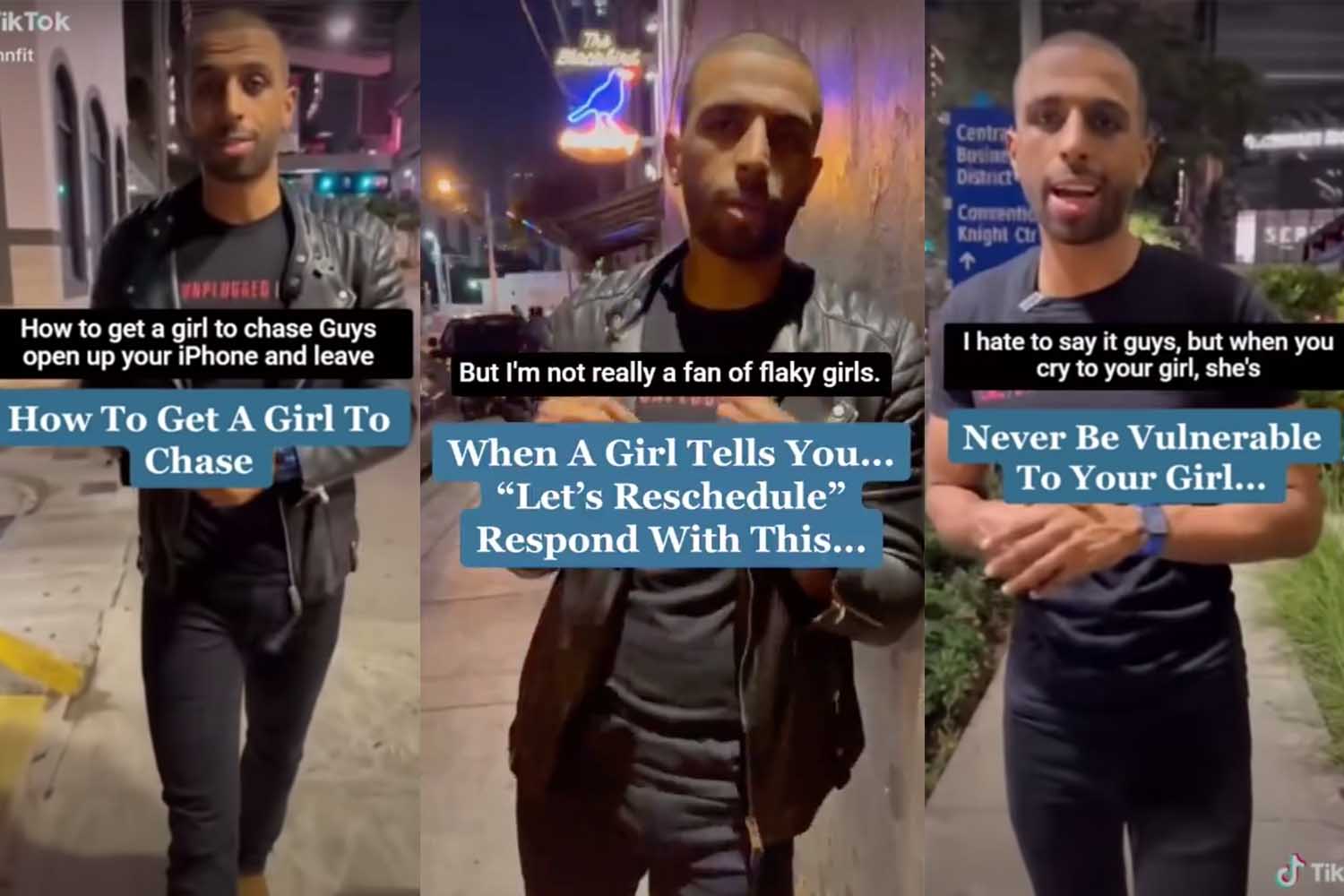When Zane Hijazi decided to undergo an invasive hair transplant procedure in October of 2019, he filmed the experience for his millions of YouTube subscribers. Almost a year later, once his hair had fully bloomed, Hijazi posted a TikTok that showed his hair restoration journey and the impressive final product in a 13-second clip. The video went viral and currently stands at over 14.2 million views and 2.4 million likes with over 10 thousand comments.
While Hijazi, a popular YouTuber and co-host of the podcast Zane and Heath: Unfiltered, already had a dedicated internet following prior to the TikTok, hair replacement videos, in general, have been going viral on the app. Popular accounts like @phildoeshair and @zackthebarber have 587.3K followers collectively with 14.8 million likes across their videos.
TikToks from these accounts often show the process of what’s called a hair system: Tops of clients’ heads are shaved, glue and a hairpiece are applied, and the final result is revealed — a shocking transformation that often ends with an ecstatic, satisfied customer.
Hair loss is an uncomfortable topic for many men and those who do seek out hair loss solutions aren’t exactly boasting about it on social media for the most part. The lack of positive hair transplant representation, in particular, can deter men from going forward with the more invasive surgery.
Hijazi, who’s only 28 years old, tells InsideHook he started seriously thinking about getting a hair transplant about a year and half before his 2019 surgery, after dealing with a receding hairline and finding zero success with off-the-shelf products. “When you’re young and you have a giant, receding hairline, it makes you look 10 times older than what you actually are, and you’re just insecure about it,” explains Hijazi, who adds he would wear a hat all the time to make himself look younger.
However, he had major reservations before finally going through with an FUT procedure. The idea of a cosmetic surgery — one that comes with a lengthy list of possible complications, and the fear of something going wrong — was, understandably, terrifying. It also didn’t help that much of the internet content surrounding transplants was focused on the negative, only stoking more anxieties about how the procedure can turn disastrous.
It wasn’t until one of Hijazi’s Twitter followers DM’d him photos of his own hair transplant photos that he felt comfortable enough to go through with it himself.
“That’s the reason why I got it,” he says. “I wasn’t able to find anything on the internet that made me feel safe to do it. It was all very scary. Talking to somebody that got a hair transplant definitely helped.”
Prior to the surgery, he had multiple meetings with his doctor, who was able to relay stories about some of the more A-list clientele who’d had the surgery, which helped mitigate Hijazi’s fears. “I went to Google images, I saw before and after pictures of a bunch of different people that have gotten hair transplants. I just couldn’t believe the results,” he says.
The fact of the matter is that lots of high-profile celebrities and maybe even people you know have gotten hair transplants — you would just never realize it. As GQ wrote recently, hair transplants now look better than ever thanks to continued research and technological advancements, with implant technology being more precise now than ever.
Many transplants these days utilize what’s called an FUE (Follicular Unit Extraction) Method. A pen-like tool meticulously extracts hair follicles from the skin and implants each follicle into bald or thinning spots, and because the minuscule FUE grafts are harvested and transplanted with micro accuracy, a natural look is easier to replicate. The method has also become more common than the Follicular Unit Transplantation (FUT) procedure which involves removing a strip of skin from the back of the head, extracting individual follicles and then applying them to bald spots. FUE offers minimal scarring compared to FUT, but there are pros and cons to each method depending on what your ultimate hair goal is.
Hijazi, who opted for the FUT method, admits he wasn’t keen on the skin-cutting technique at first, but since FUT allows for a greater number of high-quality grafts to be harvested and boasts a better growth rate, it was a better option for Hijazi who wanted more hair for his buck. “I knew that I had to do it if I wanted to get more hair on my head,” he explains. “I was like, if I’m going to do this, I’ve got to go all the way.”
The procedure took about 12 hours. Local anesthesia was administered to Hijazi’s scalp, but he was awake for the entire procedure, standard practice for both FUT and FUE methods. Both methods are virtually painless, and the 2-week recovery process, he notes, was the most painful part of the entire procedure, due to the healing incision at the back of his scalp, which called for strict movement and brought on headaches that made it difficult to sleep.
Results can start showing in as little as six months, but the final product took a little over a year to fully bloom, says Hijazi. But the temporary pain and long wait were completely worth it, he adds. “I have a full head of hair now, and seeing it and everybody’s reaction to my head, I’m very glad I did it”
After sharing his experience in a now-viral TikTok and in a YouTube video that currently has over two million views, Hijazi was surprised by the overwhelmingly positive reaction from friends, family and strangers on the internet.
“I was actually mind-blown with how much positivity came my way after I got it done. I honestly was expecting a lot of people to make fun of me for it and say, ‘You didn’t need to get that,’ in a negative way. But I got so much good feedback from it,” Hijazi explains. Since posting about his transplant, he’s also received a huge number of direct messages from men inquiring about the procedure.
“They’re older men, too. They don’t know who I am. They don’t know what I do. I think they just saw this journey. They saw my video or they saw my face in the doctor’s office. It feels really good that I’m able to help out so many men with this,” he adds.
As noted above, depictions of other hair replacement options have gone viral on TikTok as well, and it’s proven to be lucrative for businesses.
Zack a.k.a Zack the Barber, who has 80,000 followers on TikTok, tells InsideHook that he’s had more bookings for hair replacement consultations this January than in all of 2020. “The money I was able to generate from TikTok and the opportunities from TikTok alone have been unreal,” he says. “TikTok was the single most beneficial thing for my business in all of 2020. That’s for sure.”
Zack is the owner of Motley Crew Barber Company, a barbershop located in Worcester, Massachusetts that offers non surgical hair replacement called “hair systems,” a term he explains is now used instead of toupees or wigs, in an attempt to get away from the stigma associated with those awful hair pieces from the ‘80s and ‘90s.
Hair systems are an instant, more affordable hair replacement option. While they’ll still set you back around $750, it’s cheaper than an FUE or FUT procedure, which can cost anywhere from $4,000 to $30,000 depending on where you go and the kind of result you want. You don’t have to worry about the possibility of infection or your head rejecting your hair system that — both of which, while rare, are risks associated with transplants. Zack also argues hair systems provide a level of thickness that’s hard to achieve when undergoing a transplant.
They do require a bit more effort, though.
“When we sit down with somebody for a consultation, we color match them and decide on the system based on their lifestyle. Then when they come in, we decide how much of their natural hair we’re going to keep, and we’ll custom fit the system to their head, that way they can keep as much of their natural hair as possible. Then we’ll decide on the application type. We either use tape or glue and then we adhere that. And most of our applications are two weeks, if not better.”
After two weeks, you take the hair system off, clean it and then go through the process again at home for about six months before a new system is required. “We train everybody how to do it at home, because, at the end of the day, we understand it’s a big investment,” says Zack, who stresses that a hair system is not a permanent solution. “You’re going to have to do the maintenance. You’re going to have to be aware you’re wearing one. But most of the guys that I know, they love it.”
The extra upkeep doesn’t seem to be a deterrent, as Zack continues to have new clients contact him based on his viral TikToks. Many of them, he notes, are under the age of thirty. Young men seem to be more proactive in finding fixes to their early male-pattern baldness, or at least they’re more open about it. We have seen far more men unabashedly getting cosmetic fixes and procedures — but the stigma has not been fully eradicated.
Wanting to improve your appearance is one of the rare things more widely afforded to women than men, and many comments left on these viral TikToks, mainly from women, touch on this disparity and express support for men who decide to take control of their hair loss.
“Women, including myself, get hair extensions, so why shouldn’t men be able to embrace what makes them feel confident? Let people be happy,” wrote one TikTok user. “This should be way more normalized! Dudes are unfairly put in a hard spot when it comes to hair pieces/cosmetics/etc. And I’m glad it’s changing,” reads another.
Lots of men hesitate to go forward with treatments or outright ignore their hair loss completely, in fear seeking a solution will brand them effeminate.
“I know there’s a lot of men like me that suffer from hair loss and are very insecure about it,” says Hijazi. “A lot of them don’t even want to bother with it because there’s a stigma that men who put any time into their hair are less masculine.”
Hijazi hopes that, with the help of these viral videos, more men will feel encouraged to post and be open about their own hair loss journeys, not only to normalize male hair replacement but to help men who are interested in transplants and other procedures feel confident going through with them.
“I would love to see all the men that have actually gotten hair transplants because of these videos post about them because it does help a lot. Before I got my transplant, I wish there was someone I knew that had gone through it,” says Hijazi. “I remember how I felt before getting the procedure, and I just wanted to put out as much content about my transplant as possible to make it less scary for anybody that had the same problems as me.”
Additionally, posting hair transformation videos across social platforms, but specifically on TikTok, seems to be a quick ticket to virality, which, for Zack and others, has translated into financial success. So it wouldn’t be far off to assume we’ll continue to see more businesses and people posting hair replacement videos. In turn, more men will hopefully continue to seek hair loss solutions.
“I think men are always going to be insecure about their hair loss,” says Zack. “But I think these videos have definitely made a lot more people feel more comfortable doing something about it.”
This article was featured in the InsideHook newsletter. Sign up now.























